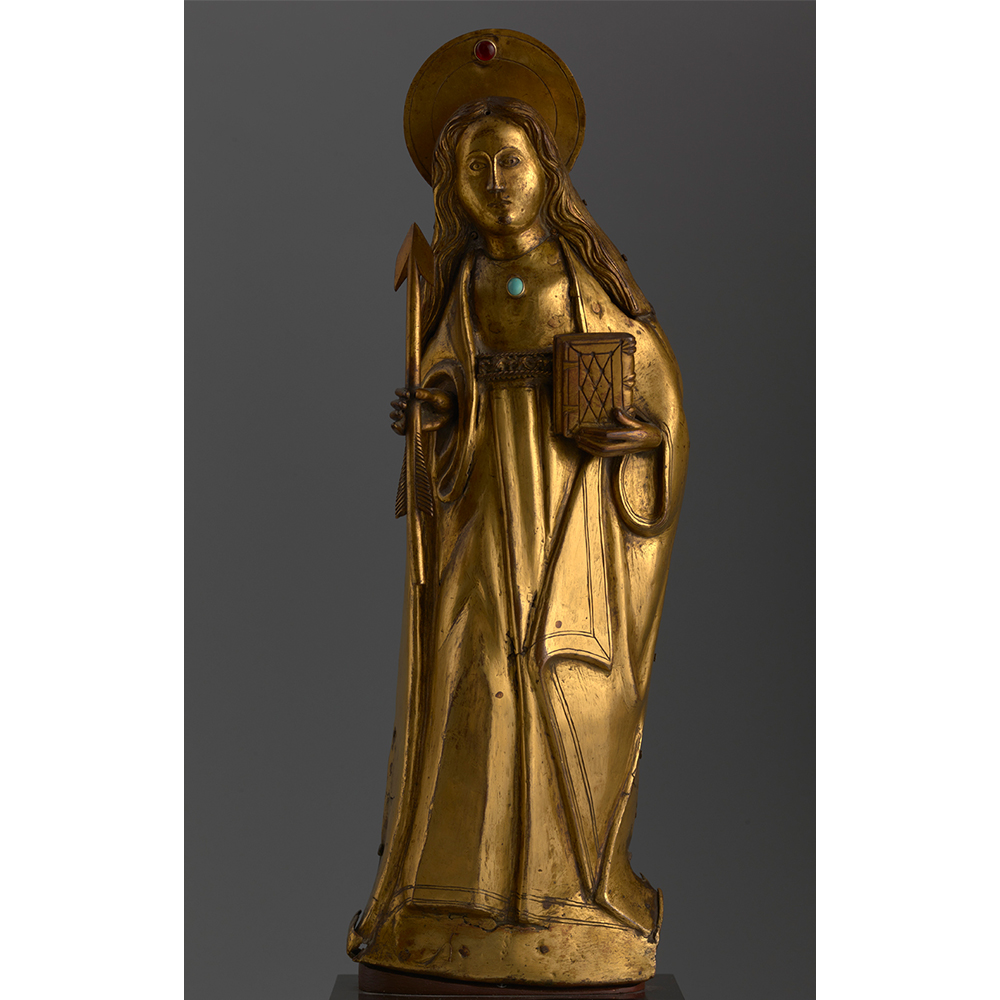Saint Ursula, from an Altarpiece Group

c.1400
Present-day Italy, central or northern
Gilt copper, glass gem, wood core Height: 16.1 in (41 cm)
Wyvern Collection, 1744
This Saint Ursula statuette represents the saint holding her standard attribute of a single arrow in commemoration of her martyrdom. The figure was originally part of a group of saintly figures with similar proportions, perhaps serving as a church altarpiece. While its origins cannot be definitively placed, the sculpture was likely produced in Tuscany, as more depictions of Saint Ursula appear there than anywhere else in the Italian peninsula during this time. Furthermore, it seems possible that the statuette was made specifically in or for Florence due to the inclusion of a statuette of John the Baptist, that city’s patron saint, in the group of which this Ursula figure was once a part (see fig. 15). (1)
The Saint Ursula statuette represents one of the most idealized female saints in medieval literature. The version of her story found in The Golden Legend, a thirteenth-century compendium of saints’ lives, was widely known. According to that account Saint Ursula, a young British princess, refused to marry before undertaking a pilgrimage to Rome. Before and throughout her pilgrimage she amassed a large number of followers, both men and women, most notably a powerful formerly pagan king; the Pope; and 11,000 virgin women. While in Cologne, Germany, Saint Ursula had a vision in which it was revealed that if she returned to that city on her voyage home she would be martyred there. Upon returning to Cologne she and her followers were attacked by Huns, and all of the Christian pilgrims were martyred for their faith, an ideal death for a medieval Christian. Saint Ursula’s beauty is an essential component of the story, as the king of the Huns was so taken by her that he offered to stop the slaughter of her followers if she would marry him. After Saint Ursula rejected his advances he shot and killed her with the single arrow that has now become key to her iconography.
In a period where it was believed that inner grace was reflected in one’s physical appearance, Saint Ursula’s geometric facial features were created to conform to late medieval standards of beauty. The statuette’s dress reinforces her character, as she wears an overcoat standard for decorous women of the early fourteenth century, and, despite her royal status, her only adornment is a decorative belt. Clothing was highly coded in the statuette’s context. Northern Italian cities during this period employed so-called sumptuary laws targeted at women to prevent wastefully ostentatious dress. (2) A woman’s clothing distinguished both her wealth and virtue: a well-dressed woman was moral, but one flamboyantly dressed was vain and frivolous. Thus, her figure and her representative dress can be read as instructional, not a true rendering of the virginal princess but a model of a perfect woman meant to be praised by men and mirrored by women.
Claudine Chartouni, Class of 2020
Notes
- Williamson 2018, p. 169.
- Britnell 1991, pp. 21–35.